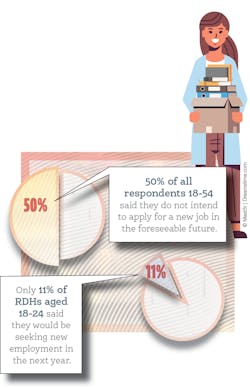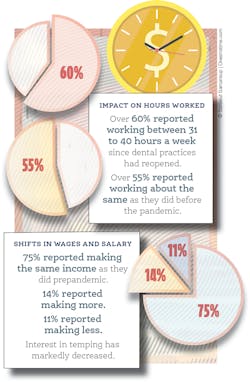Throughout the COVID-19 pandemic, DentalPost has been surveying its community of 850,000 dental professionals to track and share job trends and the impact of the pandemic on dental hiring. With the same goal, DentalPost and RDH magazine have once again partnered on a comprehensive salary survey of dental professionals nationwide. This year, in addition to our standard questions, we covered COVID-19–related topics. Dental professionals weighed in on everything from compensation and employment conditions to their general sentiments and outlook on the industry.
Audience profile
The DentalPost and RDH magazine survey, the largest of its kind, includes responses from over 10,890 dental professionals, including 4,753 registered dental hygienists. Following is a demographic snapshot of the RDH respondents.
Gender
- 97% female
- 2% male
- 1% prefer not to say or identify as other
Age
- Respondents’ ages ranged from 18 to 65-plus, with the majority falling in the 35 to 64 range.
Location
- 59% of respondents work in metro areas
- 41% work in small towns/rural areas
Experience
Similar to the previous year’s report, these respondents had a wealth of industry experience, with more than 56% of respondents having worked in dentistry for 20 years or more. Twenty-two percent had 10 to 20 years of experience, and another 22% had fewer than 10 years of experience.
Race
- 82% Caucasian
- 8% Hispanic
- 4% Asian/Pacific Islander
- 3% Black/African American
- 3% Multiethnic or other
Marital status
The majority of RDHs (70%) are married, with 75% of respondents indicating they are in a joint-income household. Of the 25% of RDHs who reported being the sole income provider, a large percentage (45%) are aged 65 and older. The increase in sole income providers after 50 years of age is indicative of a number of factors, such as being widowed, divorced, or possibly also due to a spouse’s retirement.
Highlights
Private practice versus DSO
Across all age groups, the majority (90%) of RDH respondents work at a private practice or multispecialty offices. One-third of those employed at a private dental practice are part-time, compared to 15% at a DSO. RDHs at DSOs work on average four more hours a week than those at private practices. 57% of those working at a private practice have 20+ years of experience. Those with fewer than 10 years of experience are consistent across DSO and private practice, while those with 10 years of experience are mostly employed in private practices.
Working hours
- 65% are full-time
- 29% are part-time
- 6% are unemployed or retired
While most RDHs are satisfied with their current work schedules, 25% would actually prefer to work fewer hours. RDHs prefer full-time positions when they are younger and part-time roles as they age. After age 50, the number of part-time RDHs sharply increases.
Compensation
The majority of full-time RDHs earn between $51,000 and $70,000; however, more than 15% earn over $80,000 a year. These numbers are all well above the median income for full-time working females in the United States, which in 2019 was $47,299.1
Average full-time pay by state
- Highest paying states are Alaska, California, Washington, Maryland, and Delaware
- Lowest paying states are Alabama, Mississippi, West Virginia, and South Carolina
Bonuses and raises
Thirty-two percent indicated they receive some type of bonus, and 65% had received a pay raise in the past two years. Still, 42% are either dissatisfied or very dissatisfied with their base compensation and 60% are as dissatisfied with the process to determine the raises as they are with the raise itself.
Staff mobility
When asked if they intend to apply to a new job, approximately 50% of all respondents ages 18-54 said they do not intend to apply for a job in the foreseeable future. This is likely due to the uncertainty of the pandemic and current political climate. After age 54, that number jumps considerably as those respondents are too close to retirement to warrant changing jobs.
Around a quarter of respondents across all age groups are unsure if they will apply in the foreseeable future. However, when asked if they will seek new employment when the work environment was safer, very few respondents said they would. Only 11% of RDHs aged 18-24 said they would be seeking new employment in the next year.
The temperature of the temp market
Of those respondents who engage in temporary work, the majority seem to do so as an occasional supplement to their income rather than on a regular, permanent basis. Some respondents cited temping as a way to “test drive” and find a practice they want to work in permanently.
Of those who temped…
- 83% temp in multiple offices, while just 17% temp with one office only.
- 57% preferred to have a combination of both temp and permanent work and were not making a full-time career out of temping, but rather supplementing their income.
- 76% prefer to be paid directly when they temp, being in control of their own finances and taxes.
COVID-19’s impact on dental employment
Changes to the temp market
Forty-four percent of people who temped prior to the pandemic no longer do, resulting in a significant drop in available talent to fill increased temp demands caused by quarantines, reduced staff, and unpredictable patient demand. Only 15% of respondents said they might consider temping in the future, and just 4% of respondents who didn’t temp before the pandemic are temping currently.
COVID-19 compounded dental hygienist dissatisfaction
2020 was an exceptionally challenging year for dental professionals and clinicians. Amid circumstances that included having aging parents, at-risk family members, or young children at home, some were reluctant or unable to come back to work once dental offices reopened.
In 2019, 43% of dental hygienists cited not feeling valued or respected and not receiving acceptable compensation as the primary reasons they would seek out a new job within the next year. In 2020, the COVID-19 pandemic and its effects appeared to compound these feelings of dissatisfaction, even as it made hygienists less likely to leave a job.
While the majority of respondents did not report a wage reduction as a result of the pandemic, a number of RDHs included write-in commentary in their survey responses, noting their concerns are not related to wages, but rather work conditions and their overall compensation as it relates to their contribution to production and in relation to other industries.
Following are some of the common themes and sentiments based on respondent comments:
- Being required to use paid vacation time and sick time to cover the period of office shutdown, during which time they received no payment.
- Those who returned to hygiene faced longer production days due to additional PPE change out, spaced out patient appointments, and more rigorous safety protocols to prevent infection spread.
- Additionally, respondents cited a more physically demanding workday with additional PPE and hand scaling to reduce aerosols.
The dental staffing and production conundrum
The summer of 2020 saw patient care demand and backlog surge due to the spring shutdown. As of the first week of September, that backlog peaked, but still only put practices back to roughly 65% of normal patient volume.2
With rising PPE and equipment costs and reduced patient demand, practices are not as equipped financially to compensate clinical staff commensurate with their contributions and additional workload. This is a problem that is not easily solved until patient loads return to normal. Fewer than 40% of practices reported “business as usual” in terms of patient volume. Patient volume was estimated at 77% of pre–COVID-19 levels, a slight decline over previous weeks.2
While our survey revealed some dental hygienists received a pay increase, 36% of employee dentists respondents reported having taken a pay cut. This data is consistent with the ADA’s report findings that over a quarter of employee dentists are not being paid fully.2
Nine out of ten dentists reported higher operating costs as of the week of November 2 compared to before the pandemic. Profitability of dental practices has decreased significantly.2 The latest data suggests practices are in a “new normal” and activity in dental offices is starting to slow further.2
What does the next generation of RDHs think?
RDH students shared their level of interest in a dental career before and during the pandemic on a scale of 1 to 10, with 10 being the most interested and 1 being the least interested. The weighted average of interest in a dental career only decreased slightly post–COVID-19 from 9.57 to 8.8.
References
1. Semega J, Kollar M, Shrider EA, Creamer J. Income and poverty in the United States: 2019. United States Census Bureau. September 15, 2020. https://www.census.gov/library/publications/2020/demo/p60-270.html
2. American Dental Assocation Health Policy Institute. COVID-19 economic impact on dental practices. American Dental Association. November 2020. https://www.ada.org/en/science-research/health-policy-institute/covid-19-dentists-economic-impact
About the survey co-creator
As the dental industry’s premier online and mobile job board, connecting and educating more than 850,000 dental professionals with 70,000 dental practice employers, DentalPost is uniquely positioned to partner with RDH magazine on the annual Dental Industry Salary Survey. Founded by Tonya Lanthier, RDH, DentalPost leads the industry in data and metrics-based career resources, including Match by DentalPost, a proprietary new matching algorithm, as well as personality, skills, and culture assessments to help job seekers stand out and employers find better matches, faster. DentalPost offers both permanent and temp employment opportunities, as well as tools to help you find not just any job, but the right job for you. To learn more, visit dentalpost.net or download the mobile app for iPhone or Android.










